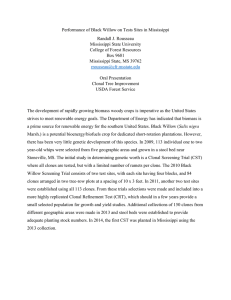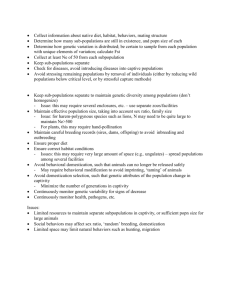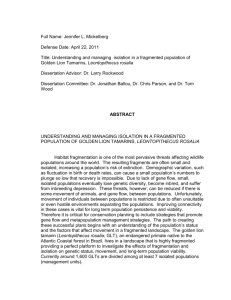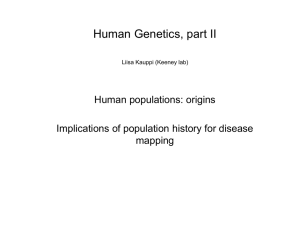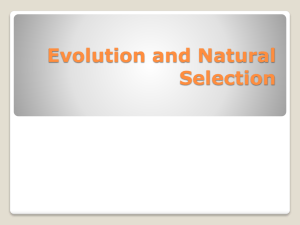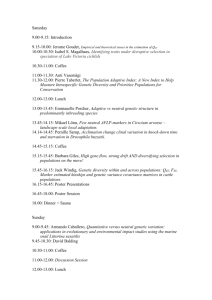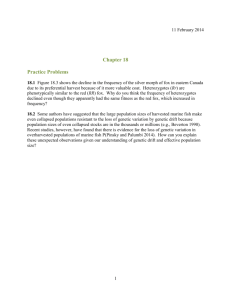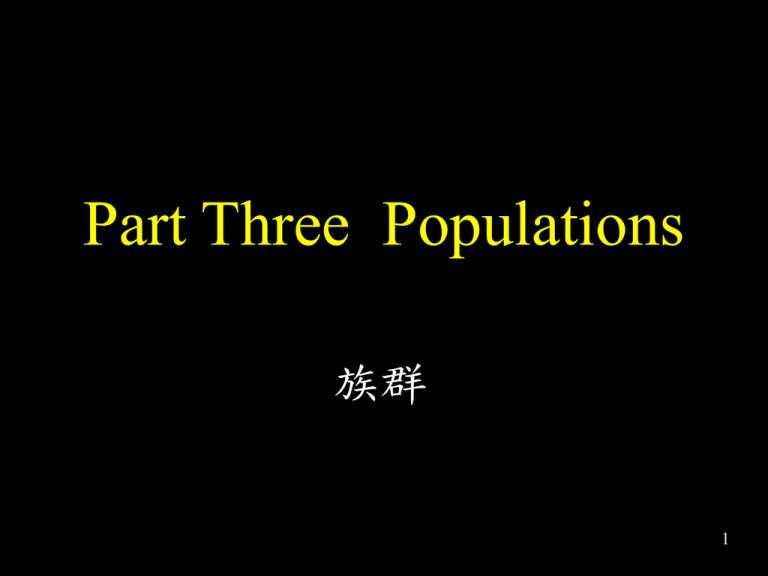
Part Three Populations
族群
1
單元重點
• 瞭解「族群」的一些基本特性。
• 討論族群的成長概念。
• 討論metapopulation的相關概念。
2
為何進行population
生態學的研究?
• 掌握及拯救瀕危物種。
• 控制有害物種。
• 進行漁、獵的管理。
• 瞭解及控制疾病的流行。
3
Chinook salmon溯溪準備進行繁殖
4
Chapter 9 Properties of
Population
族群的性質
5
A POPULATION IS A GROUP OF
INDIVIDUALS OF THE SAME
SPECIES THAT INHABITAT A
GIVERN AREA.
族群:一特定地區同一種生
物所有個體的集合。
6
The field of daisies represents a population.
7
重點說明
• 本章之目的在討論「族群」
的基本特徵,包括密度、年
齡結構、空間分佈等族群的
基本特性。
8
9.1 Organisms May Be
Unitary or Modular
個體可能是「單元的」或「多元的」
9
重點說明
• 族群是由個體所組成,但個體可以是單
一的(unitary)或組合式的(modular)。
• In modular organisms, the zygote
develops into a unit of construction (a
module), which then produces further,
similar modules.
10
重點說明
• All ramets posses the same genetic
constitution as the original product of
sexual reproduction.
• For practical purpose, ramets are often
counts as, and function as, individual
members of the population.
11
名詞解釋
• Genet: The individual arise from a
zygote is a genetic individual.
• Ramet (無性系分株): Modules
produced asexually by the genet.
12
植物的modular growth的例子
13
Connection between the original parent and its
clones are lost in time, and some clones lead
independent existences. (a) genetic parent. (b)
Clonal growth arising from root extension.
(Genetic parent is dead.
14
白榕
15
16
Examples of clonal animal species: (a) corals and (b) sponges.
9.2 The Distribution of a
Population Defines Its Spatial
Location
族群的分佈決定其空間位置
17
重點說明
• 一個族群中個體的空間分佈決定此族
群的地理範圍(geographic range)。
• 環境因子會決定一族群所能具有的空
間分佈範圍。
• 地理障礙(geographic barriers)會影
響族群的空間分佈。
18
重點說明
• 生物間的競爭或捕食關係亦會影響
族群的空間分佈(生物因子)。
• 一個族群在地理範圍內的空間分佈
可能是不均勻的,其分佈取決於物
種對各項環境因子的需求。
19
名詞解釋
• Distribution (分佈):The distribution of a
population describes its spatial location, the
area over which it occurs. ( 一個族群的空
間位置)
• Geographic range(地理範圍): The area
that encompasses the entire population of a
species. (一個物種全部個體的分佈範圍)
20
名詞解釋
• Local population (地區性族群):在一小
範圍內的同種個體。
• Metapopulation: The collective of local
populations is referred as a metapopulation.
(地區族群的集合體稱為「後族群」)
21
一假設的族群
22
紅楓( red maple)的分佈
23
苔蘚Tetraphis pellucida在不同尺度空間下的分佈 24
9.3 Abundance Reflects
Population Density and
Distribution
豐富度反映族群的密度及分佈
25
重點說明
• 族群的豐富度(abundance)由「族群
密度」及「分佈範圍」決定。
• 個體在其分佈地理範圍內可以是
「隨機分佈(random)」、「均勻分佈」
(uniform)或「團狀分佈(clump)」。
26
重點說明
• 「均勻分佈」常見於有領域性之動
物或彼此競爭的植物。
• 「團狀分佈」的形成原因多樣。
• Ecological density。
27
名詞解釋
• Abundance: The number of individuals in
the population. (族群中的個體數量)
• Population density(族群密度): The
number of individuals per unit area.(單
位面積的個體數)
28
名詞解釋
• Crude density: Density measured
simply as the number of individuals
per unit area.(單位面積的個體數)
• Ecological density(生態密度): The
number of individuals per unit of
available living space.(單位棲地面
積的個體數)
29
假想的族群分佈狀態
30
一個族群內個體的空間分佈情形
31
中亞Kara Kum沙漠植物呈現均勻分佈的情形 32
非洲疏林生態系內兩種植物的分佈情形
33
9.4 Determining Density
Requires Sampling
密度的決定需要透過取樣
34
重點說明
• 族群密度計算:「直接計算」、
「quadrats sampling」或「markrecapture」。
• Mark-recapture: N/M = n/R
• Relative density or relative abundance.
(相對密度或豐富度)
35
取樣的差異性與困難處
36
9.5 Populations Have Age
Structures
族群具有年齡結構
37
重點說明
• 生物族群可區分為:「prereproductive
(繁殖前)」、「reproductive (繁殖) 」
及「postreproductive (繁殖後) 」三個
階段。
• 要獲得族群的年齡結構,需要能判斷生
物個體的年齡。
38
幾種生態學家判斷物種年齡的方法(a)
野火雞、(b)quail、©灰松鼠、(d)蝙蝠
39
從樹木年輪估算樹木的生長情形
40
三個國家在1989年時的人口年齡結構
41
英國Sussex(薩希克斯郡)橡樹的年齡結構
42
9.6 Sex Ratios in Populations
May Shift with Age
族群的性別比會隨年齡改變
43
9.7 Individuals Moves Within
the Population
族群中的個體會移動
44
名詞解釋
• Dispersal: 個體在空間的移動。
• Emigration: 個體移出一subpopulation
• Immigration: 個體加入一subpopulation
• Migration(遷徙): Usually a repeat roundtrip(通常指的是重複來回的旅程)
45
黃楊的種子分佈與母樹距離
46
兩種脊椎動物的遷移
47
9.8 Population Distribution and
Density Change in Both Time
and Space
族群的分佈與密度隨時間與
空間改變
48
族群分佈的變化
• 氣候的變遷:冰河時期、全球暖化、
• 天然災害:颱風、地震、火山爆發、
洪水、海嘯
• 人禍:外來種、棲地破壞、獵殺
49
台灣鱒
http://www.epochhk.com/images/20060921/a6-2.jpg(王慶華攝)
50
雲林莞草在台灣的分佈有明顯北移的現象
51
外來種的問題
52
吉普賽蛾在1869年後進入北美後的擴散情形
53
吉普賽蛾對北美的橡樹森林危害極為嚴重,光
1981年的損失即高達764million美金。
54
Kudzu vines(葛藤)覆蓋土地、灌木及森林
55
虎杖
56
57
中華絨螯蟹(大閘蟹)(Eriocheir sinensis)
http://www.shwildlife.org/contentmanage/uploadfile/JPG/2008-1/22-87185-中华绒螯蟹1.jpg
58
肉球近方蟹(Hemigrapsus sanguineus)
59
60
61
62
63
褐樹蛇
•1940-1950年間進入關島。
•估計族群為1百至3百萬條。
•吃光鳥類及其它生物。
64
65
66
67
海蟾蜍 (Buffo marina)
68
69
台灣的外來種
70
71
72
73
受釉小蜂危害之刺桐
74
「刺桐釉小蜂」(Quadrastichus erythrinae)
75
布袋蓮
76
香澤蘭
77
78
79
80
81





